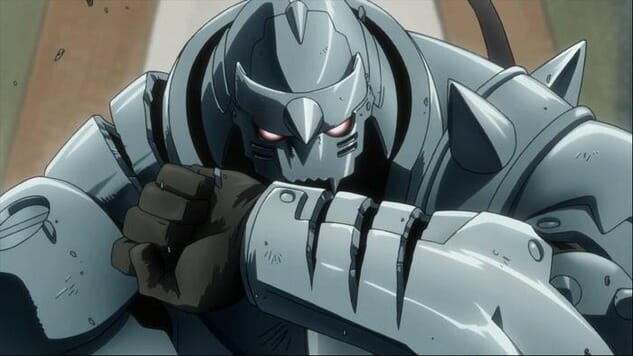
At Paste, we believe there’s an anime for everyone. With lists like this, diverse demographics are often left unconsidered, effectively sidelining female and LGBT viewers. Hobbyists and fandoms have long had distinctive, individualized communities, lively groups that often do not intersect except, maybe, at anime conventions, given over half of North America’s attendees are female. So why is it that lists like this leave out anime made by women, for women? And why can’t these anime be enjoyed by men, too?
Working on this list allowed me to examine my own taste and the sort of aesthetic that guides me. I’ve long enjoyed shoujo for its florid style and high melodrama, but when I thought of anime that deserved to be on a list of the best ever, only shows with male protagonists came to mind. Prestige anime is often centered around a man and his struggles, themes that often disclude varied viewers and create an echo chamber of impenetrable, inarguable taste for fans to discuss. These anime are great, and you’ll find many of the expected takes on this list, but in compiling this, I tried to consider every genre’s most exemplary offerings. Shows both young and old are represented, with at least one show for everyone, no matter their age, gender, or sexuality. In these anime, almost everyone can be seen in some way, whether it be in the rosy meditations of a slice-of-life show or the bombast of thrilling action.
The world of animation is constantly evolving, and we want to evolve with it. Our list is carefully curated with both accessible and challenging titles, a perfect landing pad for anime newcomers looking to dive headlong into shows that are essential, strange, or soothing. We hope you find something you’ll fall in love with.
1. Cowboy Bebop
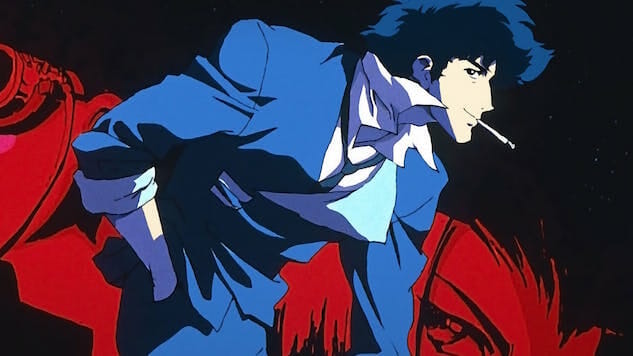
Original Run: 1998
Every debate over whether or not Cowboy Bebop—Shinichiro Watanabe’s science-fiction masterpiece—is the pinnacle of anime is a semantic one. It is, full stop. Its particular blend of cyberpunk intrigue, Western atmosphere, martial arts action, and noir cool in seinen form is unmatched and widely appealing. Its existential and traumatic themes are universally relatable. Its characters are complex and flawed, yet still ooze cool. The future it presents is ethnically diverse and eerily prescient. Its English dub, boasting some of America’s greatest full-time voiceover talents, somehow equals the subtitled Japanese-language original. Its 26-episode run was near-perfect, and episodes that might have served as filler in another series are tight, taut, and serve the show’s thesis even as they do not distract from its overarching plot, which is compelling but not overbearing. It’s accessible to new hands and still rewards old-timers with every repeated watch. Yoko Kanno’s magnificent, jazz-heavy soundtrack and score stand on their own. Its opening credits are immaculate. It’s an original property, not an adaptation. It feels like a magnum opus produced at the pinnacle of a long career despite being, almost unbelievably, Watanabe’s first series as a director. It is a masterwork that should justly rank among the best works of television of all time, let alone anime. —John Maher
2. Neon Genesis Evangelion

Original Run: 1995-1996
By now, most people have at least a cursory awareness of Neon Genesis Evangelion, whether it be from the overwhelming amount of branded merchandise or the consistent references in popular media. But for a show as ingrained in the animation canon as Evangelion, how we discuss it is in constant flux. Initially touted as a meaningful deconstruction of the mecha popularized by Gundam and Macross, the franchise later became bloated and rife with superfluous content much like the melodramas-as-merchandise they lampooned years before.
Nevertheless, Evangelion’s influence is palpable with a cultural overlay that can be seen anywhere from Persona 3 to Gurren Lagann, becoming a phenomenon that seems to exceed the show’s literal text. Much like Star Wars, its original creator Hideaki Anno has lost control of the franchise’s growth and has since augured the end of anime as we know it, once saying Japan’s animation world is “moving by inertia.” —Austin Jones
3. Revolutionary Girl Utena
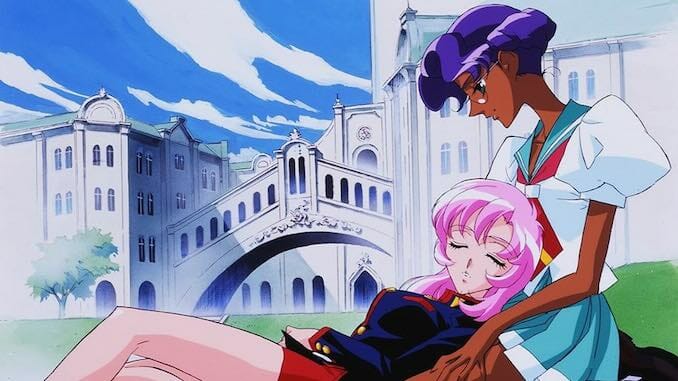
Original Run: 1997
With a psychic incision on adolescence, Kunihiko Ikuhara’s opus Revolutionary Girl Utena is a shining beacon for the shoujo genre. Inspired by the seminal works of Riyoko Ikeda and legendary all-female theater troupe Takarazuka Revue, Utena is a post-structural examination of queer identity and generational trauma filtered through a surrealist lens and romantic, heart-swelling backdrops. The show follows Utena Tenjou, a middle schooler obsessed with becoming a prince so that she might meet the prince who saved her when she was a young girl. She challenges the gender norms of her school (which may as well be a Grecoroman city-state with its own all-powerful student council and intersecting political structures) and charms the female student body with her unwavering dedication to safeguarding other women. After saving the school garden’s caretaker, Anthy, from her abusive boyfriend, Utena becomes embroiled in duels for Anthy’s possession, who is somehow instrumental to revolutionizing the world as we know it.
The show is centered almost entirely around character drama, cleverly using stock footage and repetition to foster a mythic portrait of its central cast’s shifting, intersecting psychological profiles and taboo desires. With its decadent symbolism, Utena has marked itself on anime history as much as its fellow ‘90s pioneering peers Cowboy Bebop and Neon Genesis Evangelion. —Austin Jones
4. FLCL
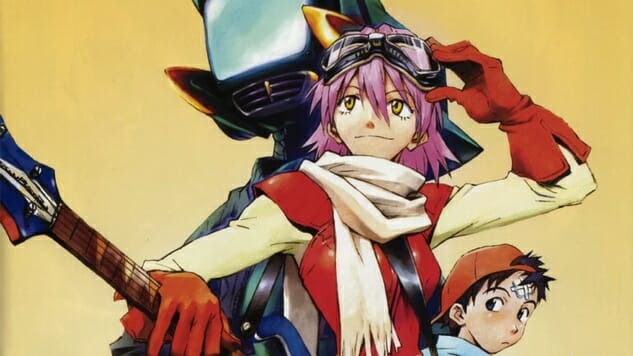
Original Run: 2000-2001
FLCL was intended to feel unlike anything else you’ve ever watched, anime or otherwise. It’s got an incredible Japanese alt-rock soundtrack from the band The Pillows. Its editing is frenetic. Its characters interact in extremes of manic, moody, or forlorn. Its plot—in which robots pop out of a young boy’s swollen, injured head, heralding the return of a powerful extraterrestrial being—kinda doesn’t matter. None of that stuff matters, according to series director Kazuya Tsurumaki. “Difficulty in comprehension should not be an important factor in FLCL,” he once wrote in a comment thread for Production IG. “I believe the ‘rock guitar’ vibe playing throughout the show is a shortcut on the road to understanding it.” Rock on, brother. —Eric Vilas-Boas
5. Fullmetal Alchemist: Brotherhood
Original Run: 2009-2010
For many, Brotherhood is the essential anime experience, and it’s easy to see why. A more faithful adaptation to Hiromu Arakawa’s mega-popular manga series than the original adaptation, Brotherhood contends with loss, grief, war, racism and ethics in mature and unique ways, ahead of its time in nearly every aspect. What’s more, the show is paced perfectly, with neatly wrapped arcs that lead into each other and bolster a greater global narrative on selected themes. Brotherhood is just the right length, never overstaying its welcome and proving how versatile and malleable the conventions of shounen anime can be.
Brotherhood has a sizeable cast of characters all of different nationalities and ideologies, with motivations that often oppose one another—the show manages to use these moving forces to form factions, alliances, and foils that flow in multiple directions, paralleling the often messy, always chaotic nature of human relationships during wartime. The show’s emotional core revolves around the plight of the Elric brothers, Ed and Alphonse, two alchemists sponsored by the authoritarian Amestris military. It’s not your classic military drama, though, as Ed and Alphonse quickly learn how far Amestris’ authoritarianism stretches.
Where Brotherhood excels lies in the sensitivity it expresses for every one of the characters fighting for their desires and contending with their mistakes, with particular highlights for the plights of minorities and women. Ed and Alphonse struggle with the fallout after attempting forbidden alchemy to revive their recently deceased mother. Later, their childhood friend Winry is portrayed heroically for acting as an emergency midwife. Scar, initially introduced as a brutal serial killer, is one of the last remaining indigenous Ishvalans, an ethnic group purged during a colonial war at the hands of Amestris—his odyssey continues to ring more and more resonant as we stray further into a post-terror world. It’s why the series continues to wow today: it eschews cliche to make cogent points on human consciousness. —Austin Jones
6. Tatami Galaxy
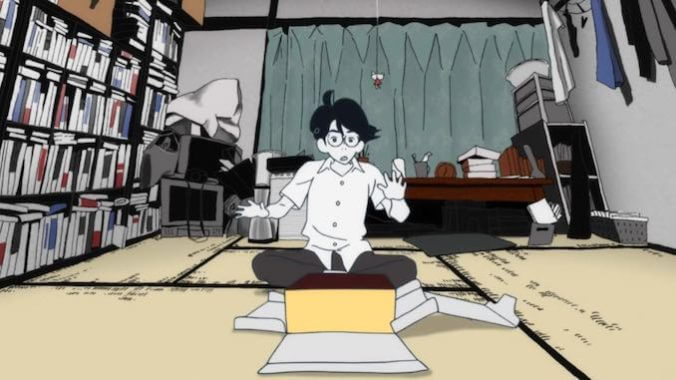
Original Run: 2010
Available for Physical Purchase
Almost any of Masaaki Yuasa’s oeuvre could make this list, but 2010’s Tatami Galaxy is the director’s most quintessential work: the characters talk with speed that could make Aaron Sorkin blush; the style is lovingly surreal, with the material delightfully mundane; the content is as cerebral as it is immediately relatable. Tatami Galaxy’s central premise circles our protagonist (who is left unnamed) as he enters college, gradually becomes disillusioned, then meets a girl and boy his fate is indivisibly bound to, and something terrible happens, resulting in the reset of his college life. Tatami Galaxy is for any fan of Haruki Murakami’s particular brand of glum magical realism, for anyone who’s felt bone-deep ennui, or simply enjoys sumptuous animation. Though the show’s loop begins to feel like a recurring trip through Dante’s vision of hell, Tatami Galaxy highly rewards rewatches and shimmers with uncanny realism. You at least have to admire how much Yuasa’s able to fit in a 20 minute timeslot. —Austin Jones
7. Fruits Basket (2019)
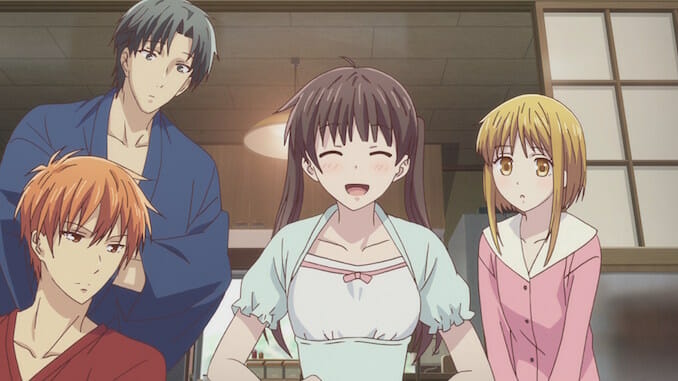
Original Run: 2019-2021
Fruits Basket’s exploration of deeply rooted familial trauma hits like a truck. Based on the best-selling shoujo manga from Natsuki Takaya, the story follows Tohru, a high schooler who recently lost her mom in an accident and subsequently finds herself taken in by two classmates estranged from their influential family. She quickly learns their secret: that Yuki and Shigure bear a “curse” that runs in the Soma clan, causing them to occasionally transform into zodiac animals. While this begins as a wacky setup, the series eventually explores the abuse wrought by those with power in this family as Tohru meets and aids the other bearers of the curse.
Although the age of the source material occasionally rears its head in ugly ways, at its core, this is a story with a great deal of empathy, and it is incredibly rewarding to watch our plucky heroine help these people confront the status quo. By its latter stretch, it grows into a consistently excellent tale about healing that foregrounds its ethics of care, tackling the interpersonal hang-ups of its extended cast with stunning gravitas. If you check it out, make sure to bring some tissues. —Elijah Gonzalez
8. Aku No Hana
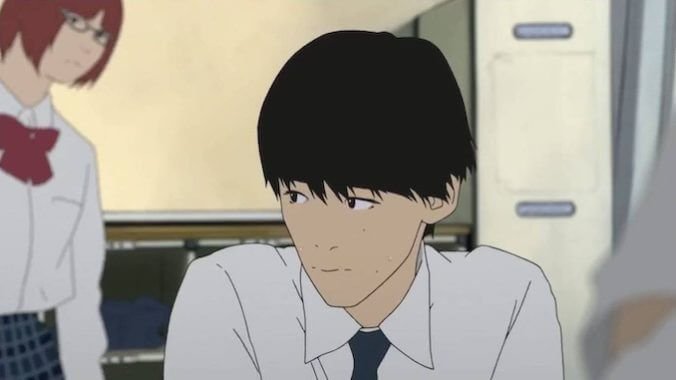
Original Run: 2013
You probably won’t like Aku No Hana. At least not on your first viewing. Proudly perverse, the show makes consistent references to Baudelaire’s Les Fleurs du Mal (of which it takes its name) as well as his contemporary Rimbaud. Among his Romantic peers, Baudelaire was the most troubled, struggling with alcoholism, aggrandizing debts, and syphilitic insanity. Somehow, a young middle schooler named Kasuga in modern day Japan found him relatable. Sensing his stranger-to-society tendencies, a fellow outcast named Nakamura catches Kasuga giving into his bawdy desires and blackmails him into a twisted friendship. The story never plays this for comedy, however—in fact, Aku No Hana is a sickeningly disgusting bildungsroman, a story about teens unable to conform and our disconnects between personal desires and social currency.
Animated with a divisive rotoscope technique, Aku No Hana flirts with drab imagery for the sake of enhancing its cast’s despair, nauseating in its flashes of uninhibited beauty and restrained repugnance. Aku No Hana will leave you feeling disquieted, but also rather seen; its revelation lies in what we want to hide about ourselves, about the dark side of our psyche that creeps in shadow. There’s something life-affirming about that darkness. —Austin Jones
9. Monster
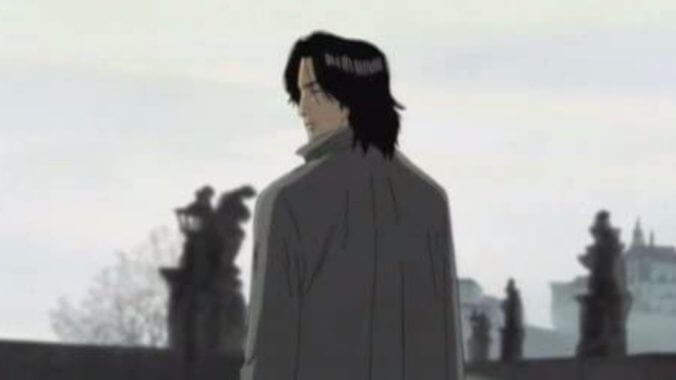
Original Run: 2004-2005
Naoki Urasawa is one of the most critically-acclaimed manga writers of his time, adored by the literary community both within and outside of Japan and the author of some of the most densely plotted, character-driven, and experimental manga ever published. So it’s only natural that Monster, Urasawa’s fifth serialized manga and one of his best known outside of Japan, would translate into one of the greatest anime series ever put to the screen. Spanning 74 episodes, the show’s premise unspools in the way only the finest crime-thriller should: patiently, yet purposefully. Dr. Kenzo Tenma’s fall from esteemed brain surgeon to disgraced murder suspect on the run, and his frenzied search for the man who framed him, is a riveting saga from start to finish, darting from one corner of Europe to the next in a deadly contest of wills. If you ever have the chance to watch this series, jump at the opportunity. —Toussaint Egan
10. Michiko and Hatchin
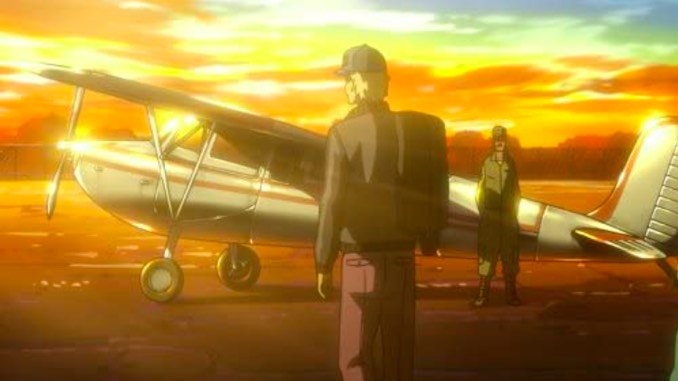
Original Run: 2008-2009
Michiko and Hatchin has all the makings of an instant anime classic: a country-spanning road trip, an irrepressible sense of adventure, a funky samba soundtrack courtesy of Brazilian artist Alexandre Kassin, and two of the strongest leads in anime history. Where the show truly shines is in Sayo Yamamoto’s directorial sense, with each scene lovingly capturing the unforgiving allure of South America. The show leads with Michiko Malandro, a convict, breaking out of prison to find her supposedly dead lover Hiroshi. Her only lead is their daughter, Hana, who lives with an abusive foster family. After plowing through their house on a motorbike, the duo travel the country looking for the only mutual connection they share.
Tackling themes of poverty and exploitation, Michiko and Hatchin is a bawdy tale that centers women every step of the way. With an intense sense of liberation, it’s one of the only anime to capture the spark that made Cowboy Bebop legendary. It deserves nothing but praise. —Austin Jones
11. Sailor Moon
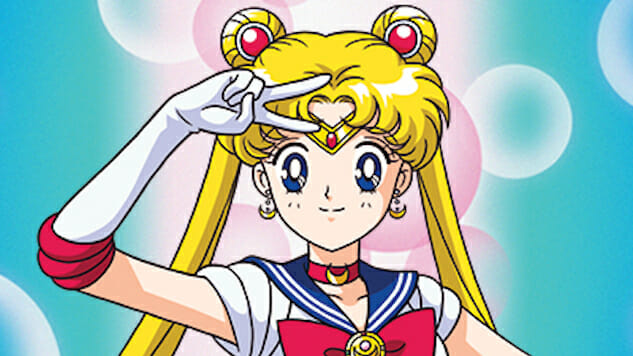
Original Run: 1992-1997
Sailor Moon taught so many girls that they can be saccharine saviors, and that kindness is the ultimate weapon. Usagi Tsukino never sheds her more unseemly traits, but experiences tremendous growth over Sailor Moon’s five-season span. The plot cycle can get a little repetitive, but Sailor Moon features some really strong lady characters, including all of the Outer Guardians and villains like Black Lady (Chibi-Usa’s evil, grown-up persona) and Queen Nehelnia, whose childhood loneliness spawns true evil. Make sure to watch every season for even more statements on gender and sexuality! —Sarra Sedghi
12. Mob Psycho 100

Original Run: 2016-2022
Shigeo “Mob” Kageyama is a psychic of unquestionable talent. Unfortunately, that’s about all he has going on in the skills department. Based on a web manga by One (One-Punch Man), Mob Psycho 100 is a psychedelic blend of coming-of-age tropes and Ghost Adventures , following Mob as he and his fraudulent mentor Reigen solve supernatural problems in Seasoning City. The show’s animation, courtesy of Bones (Fullmetal Alchemist: Brotherhood, My Hero Academia), maintains film-quality action sequences and trippy, technicolor style throughout, but what really makes it a cut above the rest is its seemingly forgettable star. Mob starts off as an unremarkable boy who just wants to be normal. His dedication to live everyday to the fullest is infectious, and by the end, he’s got a hearty cast of confidants and companions. Mob Psycho 100 might attract you with its wackiness, but its moments of emotional clarity will keep you coming back. —Austin Jones
13. Chihayafuru

Original Run: 2010-2020
Despite focusing on a card game that is relatively obscure outside of Japan, Chihayafuru conveys the soaring feelings of its cast so convincingly that it’s difficult to avoid getting pulled into the intricacies of this sport. Chihaya is a girl who finds purpose and camaraderie in competitive karuta, a card game that combines memorization, technique, and strategy. Through its thoughtful treatment of its central characters, we come to understand the complicated reasons why they are pulled into this hobby. We see the euphoria and fulfillment that Chihaya receives from finding something to strive for, as well as how her friends Arata and Taichi grapple with familial expectations and toxic forms of motivation. However, one of the show’s most ingenious strokes is how it affords the broader cast the same degree of care and interiority as its main trio. By endearing us to their foes, every showdown is made into an emotionally devastating affair. Madhouse’s adaptation of this iconic josei manga further elevates these duels with a visual language that uses gorgeous background art and abstract imagery to place us in the headspace of its competitors, making each battle feel suitably grandiose. It’s even capable of keeping us engaged during its lengthier tournament arcs by entertainingly explaining this game’s rules and strategic nuances. Between its ability to endear us to its characters and its beautiful aesthetic craft, Chihayafuru is a sports anime that you don’t want to miss. —Elijah Gonzalez
14. Vinland Saga
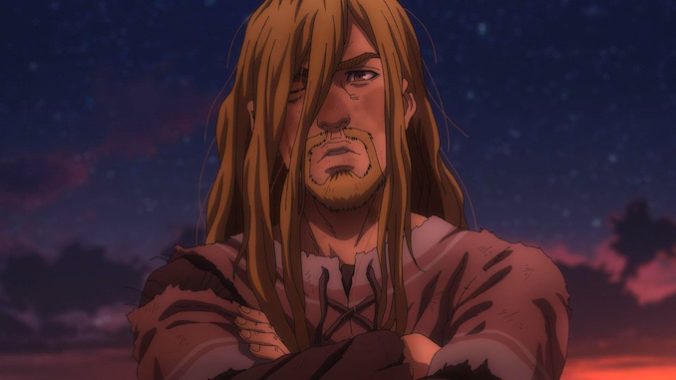
Original Run: 2019-2023
Based on the long-running manga penned by Makoto Yukimura of Planetes fame, Vinland Saga is a Norse tale told through a humanist lens. It follows Thorfinn, an Icelandic boy living in the early 11th century, who—after enduring a personal tragedy—sets out on a tale of revenge. Or at least, that’s how things initially appear. Despite resembling traditional Scandinavian poems about bloody quests for comeuppance, Thorfinn’s journey is less vainglorious and more tragic. Here warriors aren’t framed as valiant heroes battling for a place in Valhalla, but as sadists and butchers inoculated into a culture of pointless violence. Perhaps the greatest trick this story pulls is that even though it never shies away from human cruelty, it isn’t shot through with cynicism, instead suggesting a better way is just out of reach.
Sure, there is some tonal weirdness in its first half, as it enacts a series of fights that feel less like indictments of bloodshed and more like battle shonen duels between borderline superheroes, but Wit Studio’s animation chops are on such display here that it’s easy to forgive some of the amped-up, meathead shenanigans. By its second season, these inconsistencies are smoothed over as it transforms into a full-throated condemnation of the inhumanity of this period, delving into the hardships these characters face due to cruel belief structures and political systems. Between its powerful articulation of its protagonist’s emotional journey and its ability to immerse us in this fraught depiction of Middle Ages Europe, Vinland Saga is a gripping treatise on violence, revenge, and the distant hope for a better world. —Elijah Gonzalez
15. Hunter X Hunter
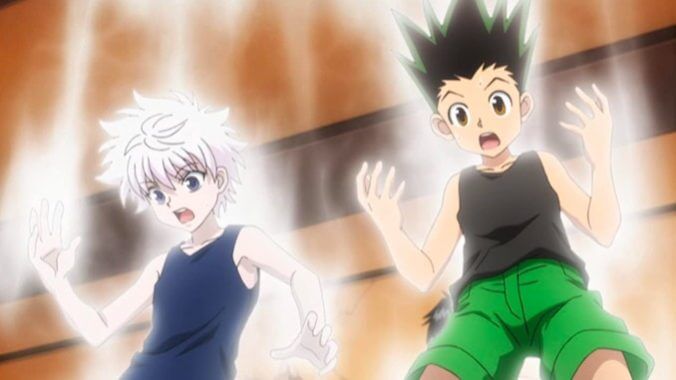
Original Run: 2011-2014
There are countless shonens (and American TV shows, even) that focus on a group of young characters using supernatural abilities and deductive reasoning to problem solve. Hunter x Hunter is a rare find among this homogeneous archetype because of its attention to detail and emotional investment. This anime is filled with whimsical subplots that don’t always end with a major event, but let you know characters in this world were alive before you started watching them.
Hunter x Hunter begins with Gon Freecss, as he sets out on a journey to become a Hunter. He’s your typical savior-figure protagonist, but fortunately he keeps the annoying, repetitive mantras to himself. His determination to see the best in people becomes a marvel of the series, and his dedication to others drives the plot. He makes friends with a young boy from a family of assassins, and their polarized dynamic creates a connection that makes the series inspiring. The compelling relationship between these two boys demands emotional investment from you. Togashi emphasizes their youth and inexperience by pitting them against much older, more experienced villains, and introduces powerful mentors that help them evolve. He’s meticulous about tailoring his characters’ abilities to their personality, but everyone draws their strength from resolve. The feats of pure determination you’ll witness in this anime will change you.
Togashi has struggled with a medical condition for some years, but he claims the manga is far from over. Hopefully, the remastered anime gets a seventh season soon. —Jarrod Johnson II
16. Ping Pong: The Animation
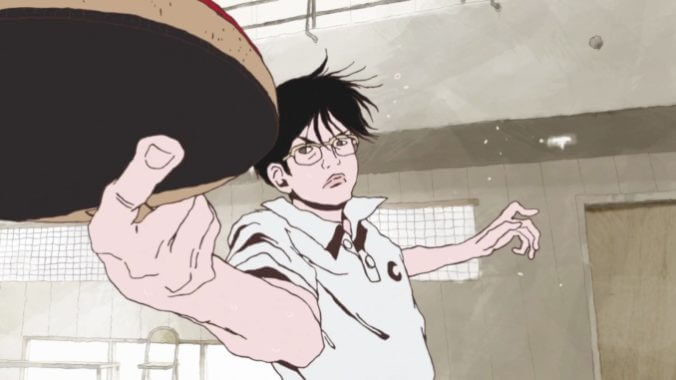
Original Run: 2014
While its idiosyncratic, scratchy art style may dissuade some, Ping Pong: The Animation is one of the most creative anime in years—one that uses its bold visual choices to communicate its powerful sentiments on the nature of competition. Peco and Smile are childhood friends who are the stars of a high school table tennis team, but after Peco is unexpectedly crushed in a match, he finds himself questioning his future with the game. Meanwhile, we also follow Wenge, Kazama, and Sakuma, three other players participating in the same tournament circuit, who each have their own deeply felt reasons for wanting to be the best.
Through these characters, it explores many underlying anxieties that define sports, such as the tensions between natural talent and hard work, as well as how obsessions with victory can chip away at feelings of self-worth. And since it follows five characters in direct opposition, it eventually portrays the importance of learning to lose and how it’s essential not to let the results of competition define us. These observations are captured via trail-blazing animation that utilizes visual motifs and clever editing to convey the passions of its cast, as the acclaimed director Masaaki Yuasa and his team bring exciting matches and roiling inner turmoils to life. It’s a series that narratively and aesthetically breaks from the conventions of most other sports stories, resulting in a rich work that lands with the power of a mighty forehand spike. —Elijah Gonzalez
17. Mobile Suit Gundam
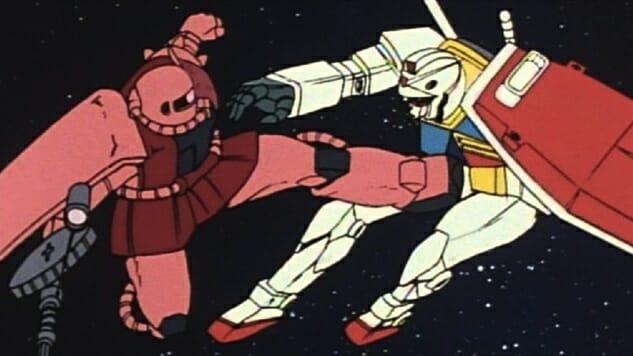
Original Run: 1979-1980
Today, it’s easy to forget—considering the countless spinoff series, films, manga, and model kits—that this legendary 1979 mecha anime was… really, really freakin’ good. The animation may look dated. The mechanical designs and character models may not move with the consistency of the later series. And the implications of its world-building, in which a separatist faction of humans abandons Earth for space colonies, hadn’t been perfectly fine-tuned. Nonetheless, Mobile Suit Gundam’s core arguments hold up four decades later: The people we ask to fight for us—often before they can maturely engage with the world—come back broken or don’t come back at all; Nazis and Nazi-lookalikes are bad; and giant robots are compulsively watchable. —Eric Vilas-Boas
18. Serial Experiments Lain
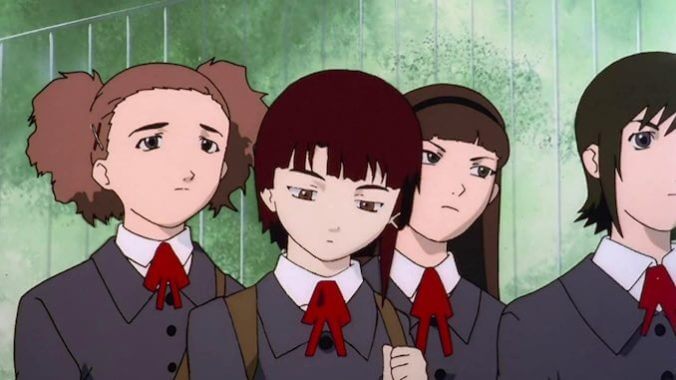
Original Run: 1998
Available for Physical Purchase
If you took every heady, philosophical cyberpunk thriller of the late 1980s and 1990s, filtered them through The Matrix and Ghost in the Shell, and then deliberately chopped and screwed the timeline, you would be left with this psychological head-scratcher of a seinen. At its center is Lain Iwakura, a shy teenage girl whose personality morphs both online and off as she becomes more and more involved with the Wired, a virtual reality world comprising, simultaneously, every communication method known to humanity. Director Ryutaro Nakamura manages to cram an extraordinary amount of metaphysical musing into the show’s brief 13-episode run, which, despite being anything but an easy watch, is exceptionally rewarding for those willing to plug into its world with an open mind. —John Maher
19. Puella Magi Madoka Magica
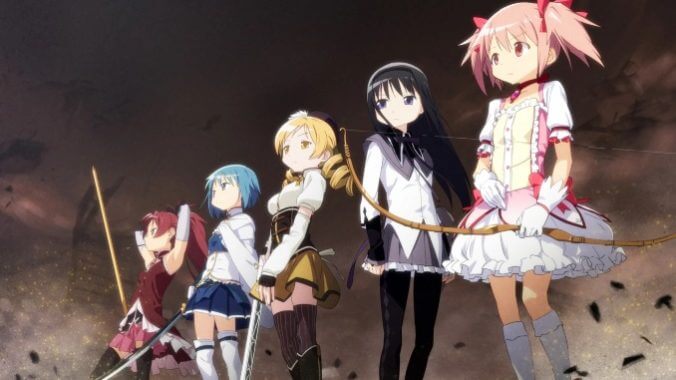
Original Run: 2011
If you’ve never heard the term “deconstruction” applied to anime, this is where to begin. This series takes the light-hearted “magical girl” archetype and completely juxtaposes it with a reality so grim it feels dystopian. The superpowers that usually empower characters become an unrelenting source of anxiety and peril which leads to grim ends. Emotionally investing in these brave young women will be a masochistic practice once you learn the truth about what it means to be a magical girl. There’s only one season, which makes for a quick and convenient watch. —Jarrod Johnson II
20. Jojo’s Bizarre Adventure
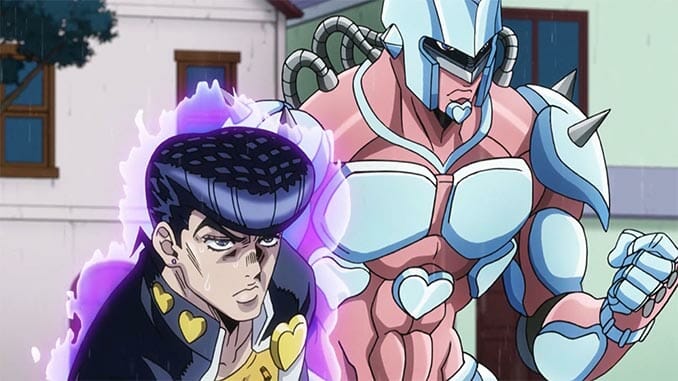
Original Run: 2012-2022
For some time, Jojo’s Bizarre Adventure has been the anime I turn to when I need some R&R. Not that anything about it, at first glance, is particularly chill—it’s an anime full of men built like classical sculptures arguing as loud as they can over psychic battles, seemingly in molasses-slow time. What feels like hours encapsulates little more than a minute in JJBA’s universe. JJBA is so much more than that, though; it’s a journey that spans a century and obliterates the rules of how to tell a traditional adventure story, taking liberal inspiration from Indiana Jones, Versace, classic rock and any other fleeting interest of mangaka Hirohiko Araki to make an explosive hodgepodge of fast-paced absurdity, a language you’ll pick up on quickly and soon find cozier than Sailor Moon. There’s a reason JJBA continues to be one of the most influential pieces of media to come out of the anime world. —Austin Jones
21. Galaxy Express 999
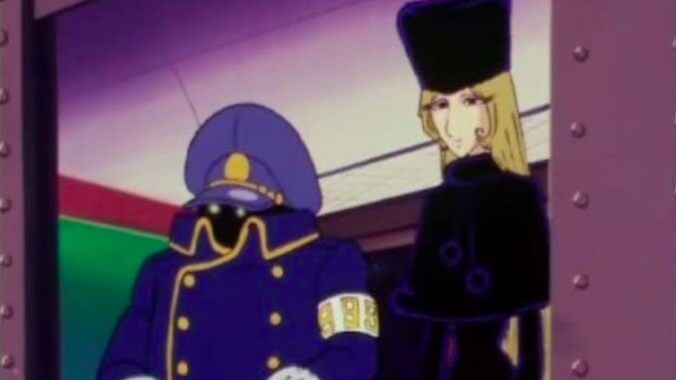
Original Run: 1978-1981
A space opera classic, Galaxy Express 999 is a perfect entrypoint for any anime fan wishing to explore the seemingly impermeable world of ‘70s animation. Series creator Leiji Matsumoto is well-known for his sci-fi works like Space Battleship Yamato and Space Pirate Captain Harlock, all of which loosely take place in the same universe, but Galaxy Express 999’s melancholic slowburn shines as his crowning glory. The show is mostly episodic, following a poor boy from Earth named Tetsuro as he boards the titular train, which supposedly leads to the Andromeda Galaxy. There, even the poor are able to receive machine bodies, which are signs of wealth for the rich and an object of great desire for the bottom rungs of galactic society. The show’s main tension comes from an overwhelming desire for immortality that drives its roving cast, frequently touching on issues of class and consciousness.
Matsumoto’s distinctive art style imbues the show with astronomical sensitivity, once telling Japan Times that, after creating Maetel, the face of the series, he “found a daguerreotype of an ancestor that looked and dressed just like her.” It speaks to the show’s reflective tone, and to Matsumoto, the immense strength of “genetic memory.” —Austin Jones
22. Princess Jellyfish
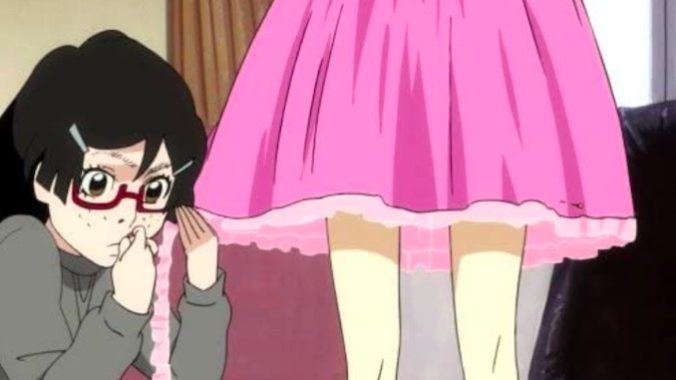
Original Run: 2010
Princess Jellyfish presents men and women in ways rarely seen in televised media. Tsukimi Kurashita has been obsessed with jellyfish since she visited an aquarium with her dying mother, an interest she carried into adulthood to feel connected to her memory. She eventually moves to Tokyo in hopes of making it as an illustrator. Unfortunately, Tsukimi is an extremely anxious person, particularly around people who meld seamlessly into mainstream society. She winds up living in an apartment complex with other female tenants, all of which have their own unique obsessions. Tsukimi’s life changes forever when she meets a friendly drag queen named Kuranosuke. Though on its surface Princess Jellyfish is your standard romcom, the story’s heart lies in its depiction of female relationships and less visible communities supporting one another. Tsukimi, who views herself as plain and unremarkable, forms a unique bond with the eccentric and carefree Kuranosuke. It’s a clever inversion of the tired Manic Pixie Dream Girl trope, and serves as the stage for Akiko Hagashimura’s heartwarming story. —Austin Jones
23. Nichijou
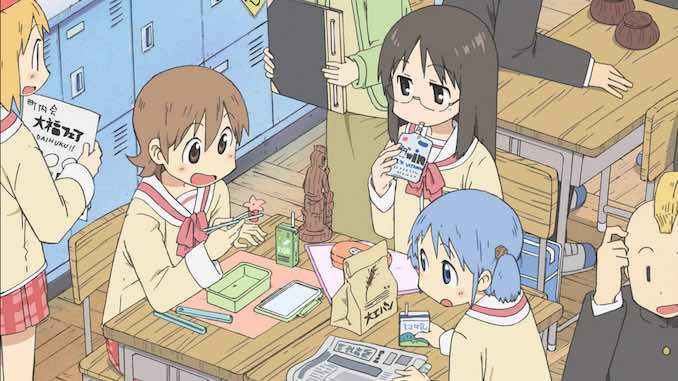
Original Run: 2011
Based on Keiichi Arawi’s manga of the same name, Nichijou excels in hyperbolic depiction of everyday life. Largely an absurdist take on the slice-of-life genre, which reached critical mass around its inception in 2011, Nichijou turns familiar tropes into devastating punchlines. Along with superb animation courtesy of Kyoto Animation, Nichijou’s irreverence is ultimately dedicated to the awkward avenues teen girls travel on their way to adulthood, and often the fear of pointing out life’s most insane moments that comes along with burgeoning public self-image. It’s a fun juxtaposition that follows up on the legacy of Azumanga Daioh and continues to influence animated comedy to this day. —Austin Jones
24. Princess Tutu
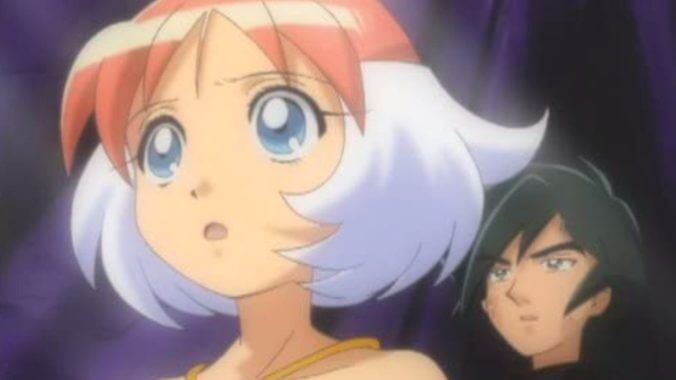
Original Run: 2002-2003
Over the last couple decades, the magical girl anime has been re-examined, deconstructed, and bastardized to death to the point that nearly any anime featuring a young female lead can qualify. Princess Tutu sets itself apart from the pack by breathing life into anime’s most formulaic genre while maintaining what it is that brings us back to cute mascots and magic wands again and again. As much a magical girl show as it is a fable, the story is centered around a duck-cum-human attending a ballet academy. Duck’s existence is constantly in question—not only is she a duck, she’s also Princess Tutu, a storybook character who must compete with the Raven and his daughter, Princess Kraehe, who attends Duck’s academy. Princess Tutu is consistently humanizing, a vigorous dance of reclaimed agency and sacrificial love, and stands above genre trappings as a riveting and timeless tale for children and adults alike. —Austin Jones
25. The Big O
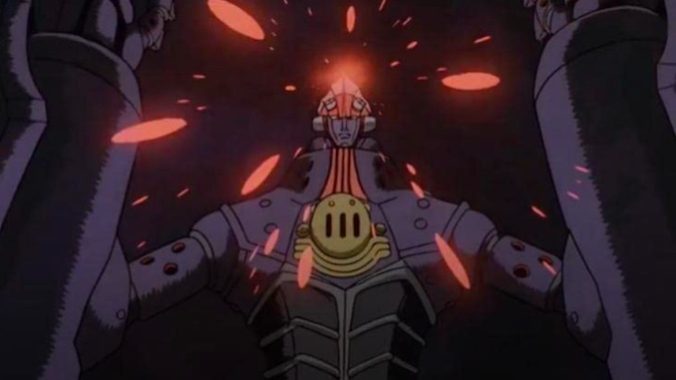
Original Run: 1999-2000
Available for Physical Purchase
In a world where Batman: The Animated Series and the Gundam franchise could fall in love, this detective noir-meets-mecha seinen, directed by Kazuyoshi Katayama, would be their progeny. Set in Paradigm City, a burg whose citizens collectively suffer from a mysterious amnesia, The Big O follows Bruce Wayne-esque protagonist Roger Smith, who serves as a freelance Negotiator—something of a cross between private investigator and lawyer—when he’s not piloting the titular megadeus (read: giant robot) Big O. Roger is assisted in his job by an Alfred Pennyworth-like butler, Norman Burg, and the android R. Dorothy Wayneright, whose very existence as part-human, part-robot highlights, as does Paradigm City’s amnesiac population, the show’s central question: What is it, exactly, that makes us human? The cult favorite starts as an episodic anime but goes full serial in its second season—released three years after its first, and bringing the show to a full 26 episodes—as Smith finds an archvillain in Alex Rosewater, the power-hungry chairman of the all-powerful Paradigm Corporation and a maniacal one-percenter dedicated to keeping the rich rich and the poor destitute—at any cost. —John Maher
26. Wandering Son
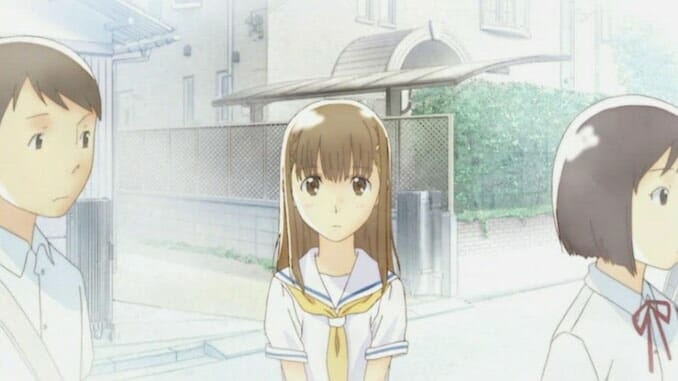
Original Run: 2011
Available for Physical Purchase
Wandering Son doesn’t need drawn out arcs and explosions to be a true anime original. The show’s about a transgender girl, Shuichi, and a transgender boy, Yoshino, as they enter middle school and navigate puberty. Wandering Son is a genuinely unique trans narrative, given how much light it provides—each of Shuichi and Yoshino’s classmates are aware of their dysphoria, and support them as best they can in their endeavors towards confirmation. The duo even meet an older trans woman who acts as a mentor throughout the show. The series doesn’t shy away from the difficult moments growing up trans, though; Shuichi’s sister, a child model, often mistreats Shuichi for her identity, jealous of the attention she gets for her appearance. Wandering Son balances the bad and the good expertly, and when paired with Keiichi Okabe’s spare score and a minimalist, water color-esque palette, the show is a gentle, if imperfect, examination of our most vulnerable period of development. At just 11 episodes, Wandering Son is one of the shortest shows on this list and a perfect watch for anyone who has ever struggled with their gender expression or wants to understand the lives of our most invisible minority. It’s an exercise in intense empathy. —Austin Jones
27. Mononoke
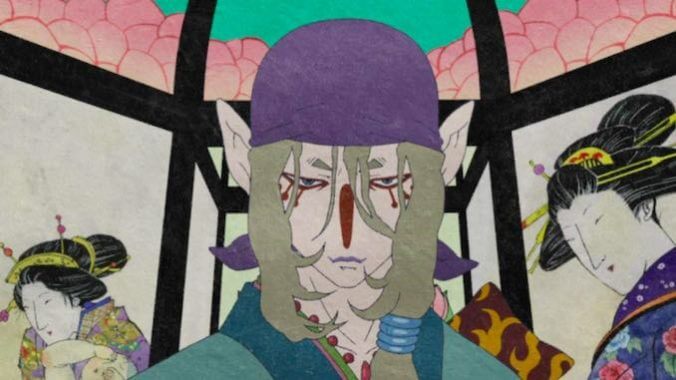
Original Run: 2007
Deftly blending Christie-esque murder mystery with supernatural horror, Mononoke is a psychedelic nightmare. With its memorable animation style mimicking the shadowless ukiyo-e painting style of 17th century Japan, Mononoke revels in maximal beauty and twitchy sound design, but it’s also successful in its emotional endeavors, proving to be more than just a directorial experiment. Mononoke are a type of yokai (a spectrum of beings in Japanese myth ranging from ghosts to demons) that prey on the negative emotions of humans. They serve as an excellent set piece for pulse-pounding psychological horror, being unafraid to delve into exigent thematic territory. Produced by Toei Animation, the show balances the grotesque with the intensely vulnerable with such harmony, often blurring color and lines with hallucinatory flair. For a show about spirits, Mononoke’s core is decidedly human. It’s sure to haunt you for years to come. —Austin Jones
28. Yuri on Ice
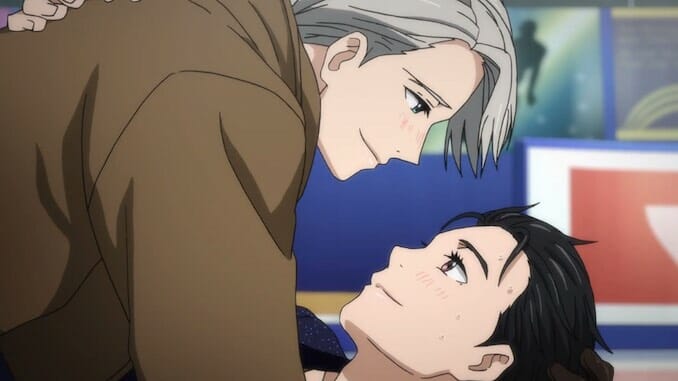
Original Run: 2016
Sayo Yamamoto and Mitsurou Kubo’s figure skating anime Yuri On Ice is beloved by all, including actual Olympians like Miu Suzaki and Adam Rippon. Yamamoto, a disciple of Shinichiro Watanabe, was a breakout director of the last decade or so, leading the equally impressive Michiko & Hatchin in 2008 and Lupin III’s achingly beautiful sexploitation spin-off The Woman Called Fujiko Mine in 2012. Yuri On Ice is what made Yamamoto a star, a much needed voice in an industry not typically friendly towards female directors. Yuri On Ice’s story of hopeful athletes might seem simple, but serves as a perfect setting for Yamamoto’s continued fascination with the complex, creative potential of human bodies. —Austin Jones
29. Den-noh Coil
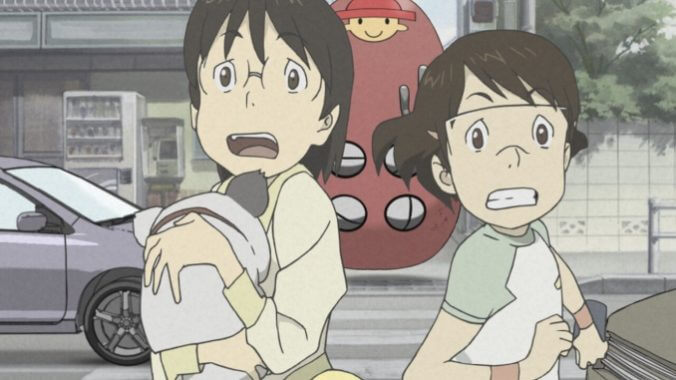
Original Run: 2007
Considering the alarming amount of new anime released every year, some never earn the following they deserve. While it’s beloved in some circles, Den-noh Coil fits this bill. Mitsuo Iso’s directorial debut is part coming-of-age tale, part techno-thriller—a prescient near-future fable that blends its disparate elements and aesthetics with ease. The story takes place in 2026, a time when augmented reality glasses have become a staple of everyday life, as a young girl named Yasako moves to Daikoku City. It’s a scenic town at the crossroads between traditional Japanese culture and the new wave of AR tech, but after befriending some of the local kids and partaking in digital adventures, they begin to unravel the secrets of this place and the grim implications of the new infrastructure that undergirds it.
Of Den-noh Coil’s many accomplishments, perhaps its greatest is how effortlessly it combines genres, mixing The Sandlot-styled kid-hijinks and a compelling slow-burn sci-fi mystery. Here, the lighthearted world of childhood suddenly veers into danger and conspiracies as the narrative explores how new inventions can be used for good or ill. It successfully captures how past and present culture blend, envisioning a near-future Japan where Shinto traditions and landmarks bleed into cyberspace, its version of augmented reality evoking folklore and ghost stories. Beyond its stellar worldbuilding, it also conveys the weight its characters carry, develops their relationships beautifully, and makes cutting arguments about the hubris of irresponsible tech companies. It’s a work with a deeply nuanced view of what the future can bring, an overlooked sci-fi masterpiece that succeeds on all fronts and has only become more relevant with time. —Elijah Gonzalez
30. DRAGON BALL Z
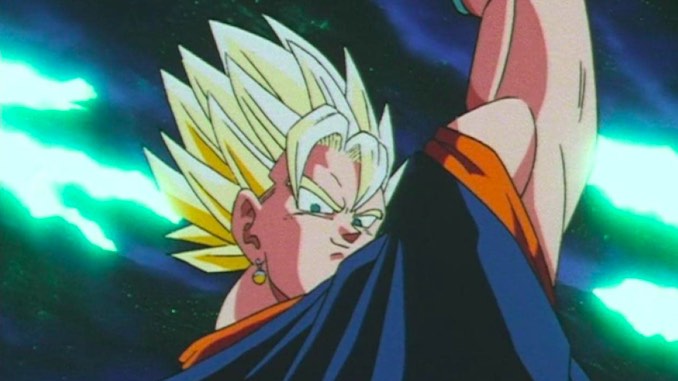
Original Run: 1989-1996
In every practical sense, Akira Toriyama’s status as one of anime’s greatest creators was all but secured with Dragon Ball. Loosely inspired by the classic Chinese novel Journey to the West, the manga and subsequent anime series of Son Goku’s misadventures to collect all seven of the mythical dragon balls inspired whole generations of manga artists and animators in Japan. The original series was a classic, but it was Dragon Ball Z that marked the series’ transition from a national treasure into a worldwide phenomenon. With hyper-kinetic violence, flashy energy attacks, dizzying spectacles of mass destruction, and tense moments of serial escalation, Dragon Ball Z is a singularly important installment in the canon of martial arts action anime and an enduring entry point for newcomers to the medium to this day. —Toussaint Egan
31. Lupin III
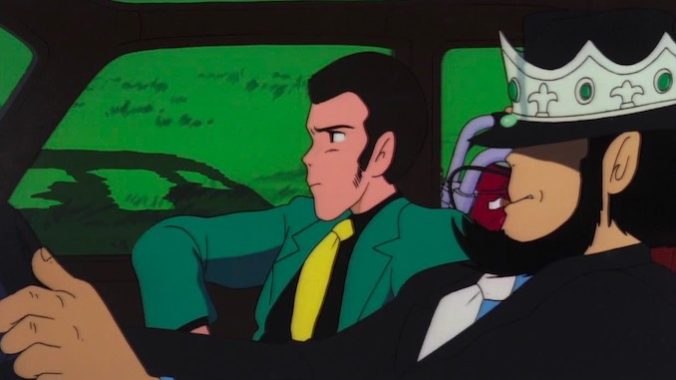
Original Run: 1971-2018
Lupin III is anime’s most iconic gentleman thief—a rakish criminal genius who first showed up in manga runs from the late ’60s while Sean Connery was defining James Bond. Lupin’s approach is similar: He fights, he fucks, he steals things, and he’s the grandson of the OG gentleman thief, Arsène Lupin. Lupin III’s adventures now span a half-century franchise, but what’s more notable is how many anime series claim the character, originally created as contract work, as an influence. Cowboy Bebop’s Spike Spiegel flat-out wouldn’t exist without Lupin’s character as a model. Hayao Miyazaki wouldn’t have had his first shot at directing features without the intricately detailed movie The Castle of Cagliostro. “At the end of that three months, it became popular and I continued drawing it for 10 years,” the creator Monkey Punch has said. The rest is history. —Eric Vilas-Boas
32. The Vision of Escaflowne
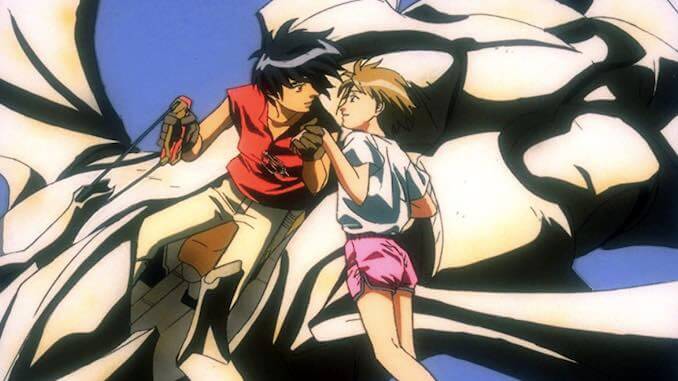
Original Run: 1996
Available for Physical Purchase
The Vision of Escaflowne is just about the full fantasy package. It’s got dragons, an alternate Earth rent asunder by war, steampunky robots, gorgeous sword-duel animation, tarot cards, and a rad symphonic soundtrack masterminded by the legendary Yoko Kanno. The elements may all be recognizable, but the chemistry works perfectly. Escaflowne’s still a blast to watch, but it’s probably most notable for the murderers’ row of names behind it. Shoji Kawamori (Macross franchise mastermind) created the series; Ryota Yamaguchi (One Piece, Ranma ½, Sailor Moon) wrote much of it; Shinichiro Watanabe (Cowboy Bebop) did storyboards; Kanno (also Bebop) did the music; Hiroshi Osaka (cofounder of the anime studio BONES) directed animation; and Yasuhiro Irie (Fullmetal Alchemist: Brotherhood) co-directed an episode. Its visionary legacy lived on. —Eric Vilas-Boas
33. Kare Kano: His and Her Circumstances

Original Run: 1998-1999
Available for Physical Purchase
Hideaki Anno’s take on the romantic comedy genre is, of course, a strange examination of conventional genre tropes. Anno’s adaptation of Kare Kano: His and Her Circumstances was notoriously reviled by mangaka Masami Tsuda, but nevertheless became a cult favorite among shoujo fans for its playful exuberance and psychological spin on melodrama. If you can ignore the show’s dwindling budget affecting the show’s quality in its final episodes, Kare Kano is an innovative work that questions the tenets of the will-they-won’t-they by asking what happens when they do? Where do we go after that? The show’s themes are only bolstered by its beautifully flawed central duo—the couple’s issues are palpable and so human, a refreshing change from the petty miscommunications that often drive the plots of romcoms (anime or otherwise). As introspective as it is hilarious, Kare Kano is an essential show for any anime fan, new or old. —Austin Jones
34. BERSERK
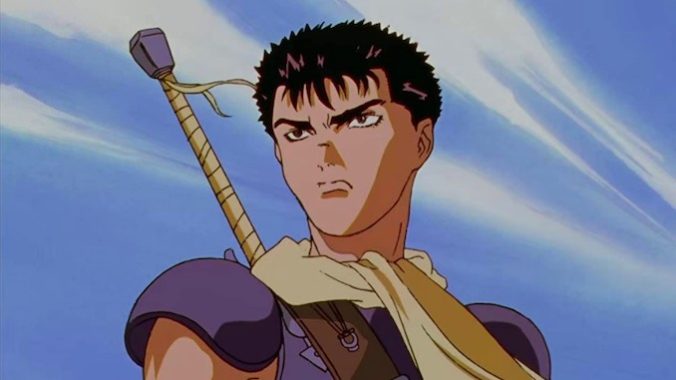
Original Run: 1997-1998
Available for Physical Purchase
Kentaro Miura’s Berserk is one of the most critically-acclaimed action series of the 1980s. Spanning 40 volumes and counting, the long-running manga, which follows Guts the Black Swordsman’s Sisyphean quest for revenge across the blighted plains of Midland, has spawned legions of fans over the series’ almost 30-year history. There’s been a handful of anime adaptations in that time, some more risible than others. The 1997 anime, produced by OLM, directed by Naohito Takahashi, and written by Yasuhiro Imagawa, is to this day widely regarded as the finest adaptation of Berserk ever made and considered a major contributing factor to the series’ ongoing popularity. With an iconic soundtrack by Susumu Hirasawa, intense battles, engrossing characters, and an ending that will shake you to your core, Berserk is a harrowing yet highly recommended plunge into a world fraught with feudal strife and cosmic cruelty. —Toussaint Egan
35. Pluto
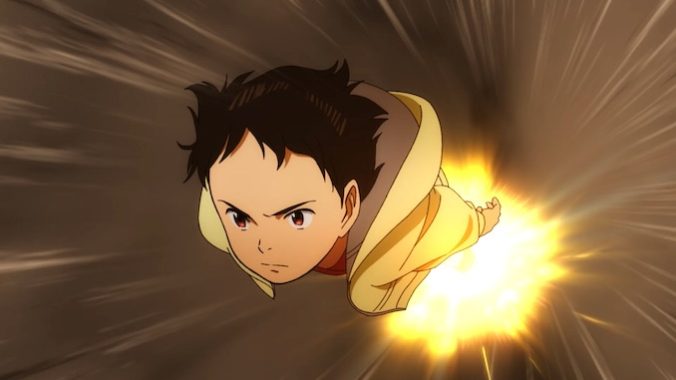
Despite a widely celebrated body of work, only a handful of Naoki Urasawa’s beloved manga have made the jump to the small screen. One of these few adaptations is Pluto, a murder-mystery reimagining of the seminal Astro Boy, and the results are dazzling. It follows a detective named Gesicht as he unravels a case that invites questions about the personhood of androids and ties into the scars of an unjustified war. On its face, many of this story’s ideas have been interrogated ad nauseam, stretching as far back as when Asimov first penned the laws of robotics, but where it differs is in its execution. While science fiction can often feel as cold as these machine lifeforms’ chrome exteriors, this tale focuses on the warmth found in the buzzing circuity beneath. In half an episode or less, we’re endeared to the trials and tribulations of seven robots in the crosshairs of a rogue killer as flashbacks reveal a horrible conflict etched into their unchanging digital memories. The winding mystery at the center of the story smartly connects anti-war sentiment and ruminations on artificial consciousness, and while there is a lot to keep track of, the propulsive pacing of Gesicht’s investigation keeps everything focused. It all makes for a beautifully constructed work of sci-fi that, much like the robots at the center of this story, is full of humanity. —Elijah Gonzalez
For all the latest TV news, reviews, lists and features, follow @Paste_TV.
